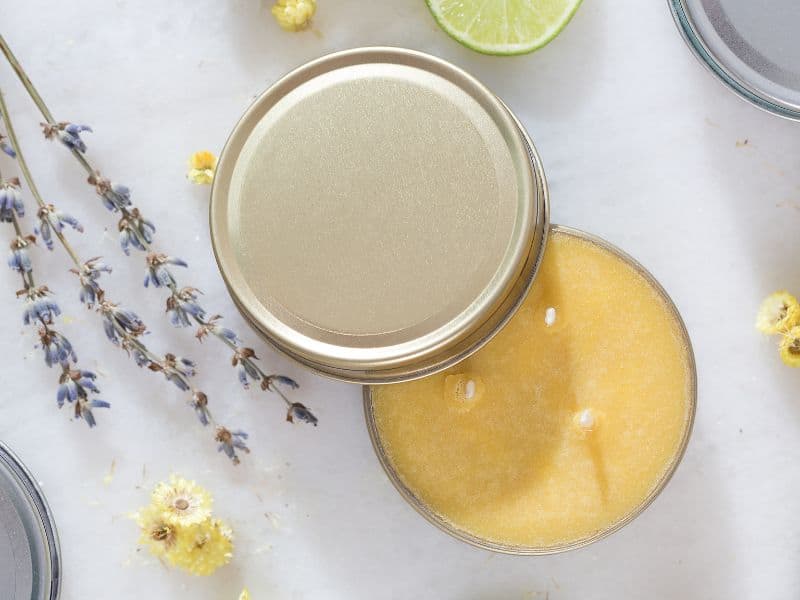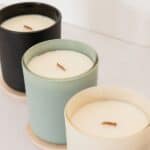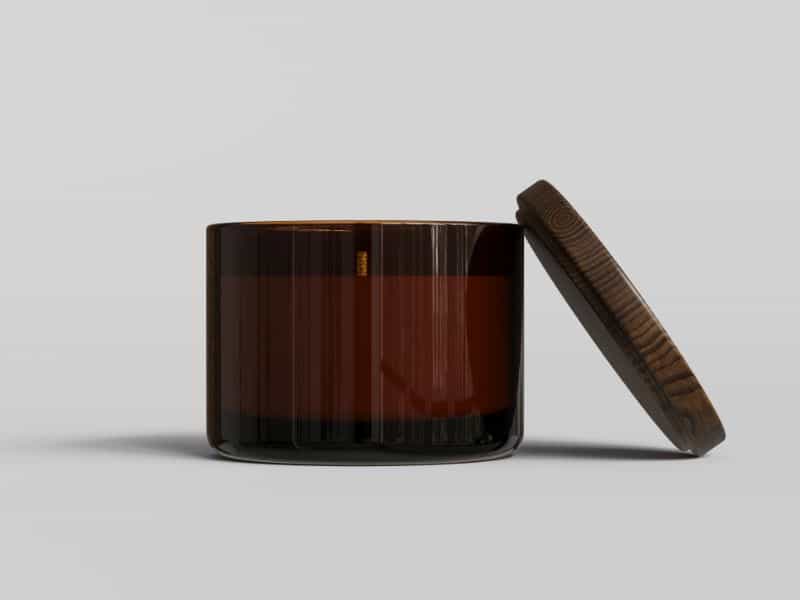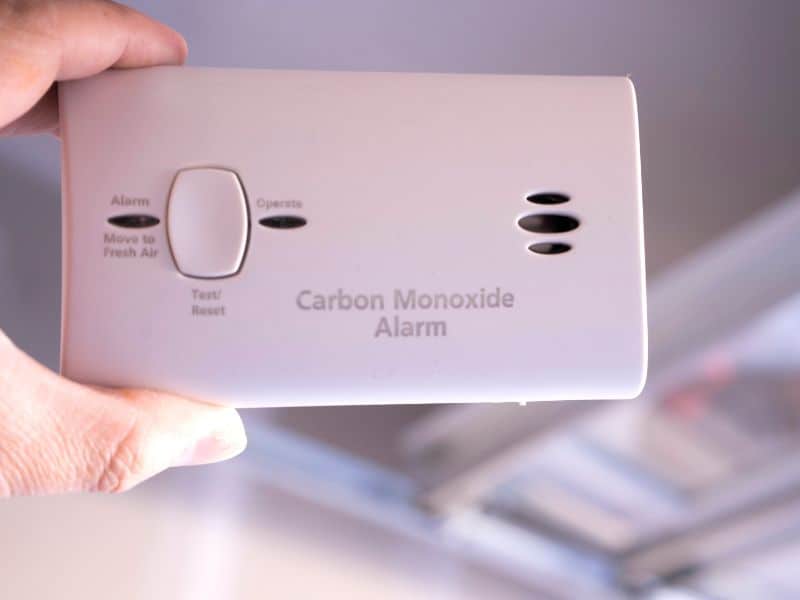Yankee Candles are a household name, known for their variety of scents and decorative jars. Their widespread appeal has led to many people questioning their safety and potential risks.
Yankee Candles contain paraffin wax, which can release harmful chemicals like benzene and toluene when burned. These substances can contribute to indoor air pollution, potentially causing issues for sensitive individuals. Use caution and proper ventilation.
It is worth mentioning that studies have shown burning paraffin candles in a well-ventilated room exposes people to minimal amounts of these chemicals. So if you are in an open and well-ventilated room you are likely to be fine.
Let’s take a closer look at Yankee Candles and if they can potentially be toxic below.
What are Yankee Candles Made Of?
Paraffin Wax Composition
Yankee Candles use paraffin wax, a petroleum byproduct. While affordable and widely used, paraffin wax releases potentially harmful chemicals when burned, such as benzene and toluene. These substances can contribute to indoor air pollution and may affect respiratory health.
Fragrance Oils
Yankee Candles derive their scents from synthetic and natural fragrance oils. Some individuals may experience allergic reactions, headaches, or respiratory issues when exposed to these fragrances. It’s essential to be cautious if you have allergies or are sensitive to scents.
Wicks and Dyes
Yankee Candles feature cotton wicks, which are often coated in metal to improve their stability. Although the company stopped using lead in their wicks, other metals like zinc might still be present. Additionally, the dyes used to color the candles could potentially release chemicals when burned.
Potential Health Risks
Paraffin wax itself isn’t toxic, but burning it can release harmful chemicals. When candles with paraffin wax burn, they emit substances like benzene and toluene, which have potential links to health issues.
Soot and Indoor Air Pollution
Burning paraffin candles may produce soot, a black residue that can accumulate on surfaces and affect indoor air quality. Inhaling soot particles could lead to respiratory problems, especially for people with asthma or allergies.
Allergic Reactions to Fragrances
Some individuals may experience allergy symptoms or sensitivity to synthetic or natural fragrances in candles. These reactions may include headaches, sneezing, or difficulty breathing.
Lead from Wicks
Yankee Candles no longer use lead in their wicks, but other metals like zinc may still be present. Although the risk is lower, inhaling metal particles could potentially harm your health.
Are Yankee Candles Toxic to Pets?
Common Pet Concerns
Pets, like humans, can be affected by the chemicals and fragrances in candles. Cats and dogs have sensitive respiratory systems, making them vulnerable to airborne irritants.
Avoiding Pet Exposure
Ensure proper ventilation when using candles around pets. Keep candles out of their reach and monitor them for any signs of distress or unusual behavior.
Signs of Toxicity
If you suspect your pet has been exposed to harmful substances from candles, look for symptoms such as coughing, sneezing, difficulty breathing, lethargy, or vomiting. If you notice any of these signs, consult your veterinarian immediately.
Choosing Safer Alternatives
Soy or Beeswax Candles
Opt for candles made from soy or beeswax, which burn cleaner and produce fewer harmful emissions than paraffin. They’re derived from renewable resources, making them more environmentally friendly options.
Essential Oils and Diffusers
Consider using essential oils with a diffuser to enjoy scents without burning candles. Diffusers release fragrances without producing soot or harmful emissions, making them a safer choice for those with allergies or respiratory concerns.
Unscented Candles
For those sensitive to fragrances, unscented candles can provide ambiance without triggering allergic reactions. Look for candles made from soy or beeswax to ensure a cleaner burn.
Eco-friendly Candle Options
Sustainable Materials
Choose candles made from eco-friendly materials like soy or beeswax, which are derived from renewable resources and produce fewer emissions.
Reusable Containers
Consider candles with reusable containers, such as glass or ceramic jars, which can be repurposed after the candle has burned down, reducing waste.
Supporting Local Businesses
Purchasing candles from local artisans or small businesses helps promote sustainability and supports your community.
Eco-friendly Candle Brands
ECOYA specializes in candles made from natural soy wax, which burns cleaner and lasts longer than paraffin wax. Their fragrances are derived from premium-quality essential oils, and the candles come in stylish, reusable glass jars.
BeeHive Candles offers 100% pure beeswax candles, handcrafted with minimal processing. Beeswax candles burn brighter and cleaner than other waxes, releasing a subtle honey scent. BeeHive Candles are also hypoallergenic, making them suitable for allergy sufferers.
P.F. Candle Co. creates hand-poured, vegan soy candles with plant-derived fragrances. Their candles are free from phthalates, parabens, and other harmful chemicals. The company uses recyclable packaging and encourages customers to repurpose the amber glass jars.
GoodLight Natural Candles produces candles made from sustainably sourced, non-GMO palm wax. Their candles are free from paraffin, lead, and synthetic fragrances, ensuring a clean burn. GoodLight is also a partner of the Roundtable on Sustainable Palm Oil (RSPO), committed to responsible palm oil production.
Seventh Generation, known for eco-friendly household products, also offers candles made from plant-based wax. Their candles are free from petroleum-based ingredients, synthetic fragrances, and dyes. They prioritize sustainable sourcing, helping to reduce the environmental impact of their products.
Tips for Using Candles Safely
Proper Ventilation
Ensure adequate airflow when burning candles to disperse any emissions and reduce the risk of indoor air pollution. Open windows or use fans to maintain air circulation.
Regular Wick Trimming
Trim the wick to 1/4 inch before each use to minimize soot production and ensure a cleaner burn. This also prevents excessively large flames and reduces the risk of fire.
Fire Safety Precautions
Never leave burning candles unattended, and keep them away from flammable materials. Use stable, heat-resistant surfaces for candle placement, and extinguish candles before they burn too low to avoid overheating containers.
Frequently Asked Questions
Not all scented candles are harmful. However, some individuals may be sensitive or allergic to certain fragrances, leading to headaches, sneezing, or difficulty breathing.
Soy and beeswax candles burn cleaner, producing fewer harmful emissions than paraffin wax. They are also derived from renewable resources, making them more environmentally friendly options.
Essential oil diffusers can provide a pleasant fragrance without the need for burning candles. They release scents without producing soot or harmful emissions, making them a safer choice for people with allergies or respiratory concerns.
Open windows or use fans to maintain air circulation when burning candles. This helps disperse any emissions and reduces the risk of indoor air pollution.
Many countries, including the United States, have banned the use of lead in candle wicks. Look for candles that explicitly state they are made with lead-free wicks or purchase from reputable brands.
Some individuals may experience headaches due to sensitivity or allergic reactions to synthetic or natural fragrances in candles.
While the occasional use of scented candles is likely safe during pregnancy, it’s best to minimize exposure to synthetic fragrances and chemicals. Opt for natural alternatives like soy or beeswax candles with essential oils.
Candle soot can accumulate on surfaces and affect indoor air quality. To minimize soot production, trim the wick to 1/4 inch before each use and ensure proper ventilation while burning candles.
Conclusion
In conclusion, while Yankee Candles are popular and visually appealing, their paraffin wax composition raises concerns about potential health risks and indoor air pollution. By considering safer alternatives like soy or beeswax candles, essential oil diffusers, or unscented candles, you can create a cozy atmosphere without compromising your well-being or that of your pets.
Additionally, opting for eco-friendly brands supports sustainability and responsible sourcing. Always remember to practice candle safety by ensuring proper ventilation, trimming wicks, and following fire safety precautions. By making informed decisions, you can enjoy the warmth and ambiance of candles while prioritizing health and the environment.






